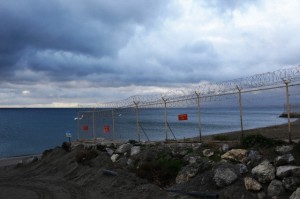
A tragedy on a Spanish border beach a year ago shows how the EU’s border policies are forcing thousands of people to take ever greater risks to reach Europe.
Exactly one year ago today, at least 14 people died just metres from Tarajal beach in Ceuta, a tiny Spanish enclave bordering northern Morocco.
We know a lot about what happened that morning, thanks to video footage and testimony from survivors. But a year after the tragedy only one of the victims has been formally identified by the Spanish Government, the others remaining nameless.
Around 200 people tried to enter Spain at dawn that day. Fourteen of them drowned and 23 were sent back to Morocco after being picked up by Spanish Civil Guards on Spanish soil.
After repeated denials from Spain’s Interior Minister, Fernández Díaz, the Secretary of State for Security, Francisco Martínez told Congress that Civil Guard officers had used “anti-riot equipment” to stop the migrants reaching Spain, firing 145 rubber bullets and five smoke canisters.
So we know that Spanish officials fired at the people in the water, who were also being pursued by a Moroccan patrol, but we don’t know their names, or who gave the order.
Martínez emphasized that none of the men who reached the Spanish shore were injured and that the Civil Guard had only fired when people were still in Moroccan waters. But why did no one try to rescue those who were drowning?
Spain’s Secretary of State for Security says the officers weren’t permitted to enter foreign waters. So the border stopped them from rescuing drowning men, but it did not stop the rubber bullets. At least fourteen people paid with their lives.
What happened that day is the starkest example yet of the Spanish Government’s border policy: No entry. At any cost.
The nameless deadWho were the people who died that morning? The identity of at least six men is thought to be known, but none except one has been officially identified and it now seems impossible to identify them all. Once again, we know the numbers, but officially they have no names.
Videos and personal testimony indicate that most were young men from sub-Saharan African countries. We can guess that they died in the last stage of a journey that took months, if not years. Perhaps they were escaping from conflict in Africa or the Middle East. Perhaps they wanted to join relatives in Europe or were simply fleeing from hunger.
Perhaps some of the 14 dead men and the 23 who were sent back to Morocco after reaching the Spanish shore were persecuted for their political ideas, ethnicity or sexuality at home. If so, this would have required Spain (in accordance with its own laws) to give them refugee status.
We will never know. And the Spanish government has made it normal practice to push people back across the border before asking questions in Ceuta and Melilla, its other north African enclave.
A symbolic tragedyWhat happened at Tarajal beach shows how Spanish and European border policies are forcing thousands of people to take ever greater risks to fulfill their dream of a better life, or to simply survive. An estimated 22,000 people have died trying to reach Europe since 2000.
Why risk your life if you could simply seek asylum and state your case, according to international law?
A year has gone by, but Spain’s border policies haven’t changed. The Tarajal investigation seems to have ground to a halt. We might never be able to hold anyone accountable for these deaths, and ensure a similar tragedy doesn’t happen again.
However, something has changed in the last year. For the worse. The Spanish government now plans to use its new Public Security Law to automatically send back to Morocco anyone crossing the Ceuta and Melilla borders. This will break the international standards that Spain is bound to observe.
No law can stop the humanitarian drama unfolding at Europe’s borders. Only by treating migrants and refugees with humanity, according to international law, can we avoid causing new, nameless tragedies on our shores.


